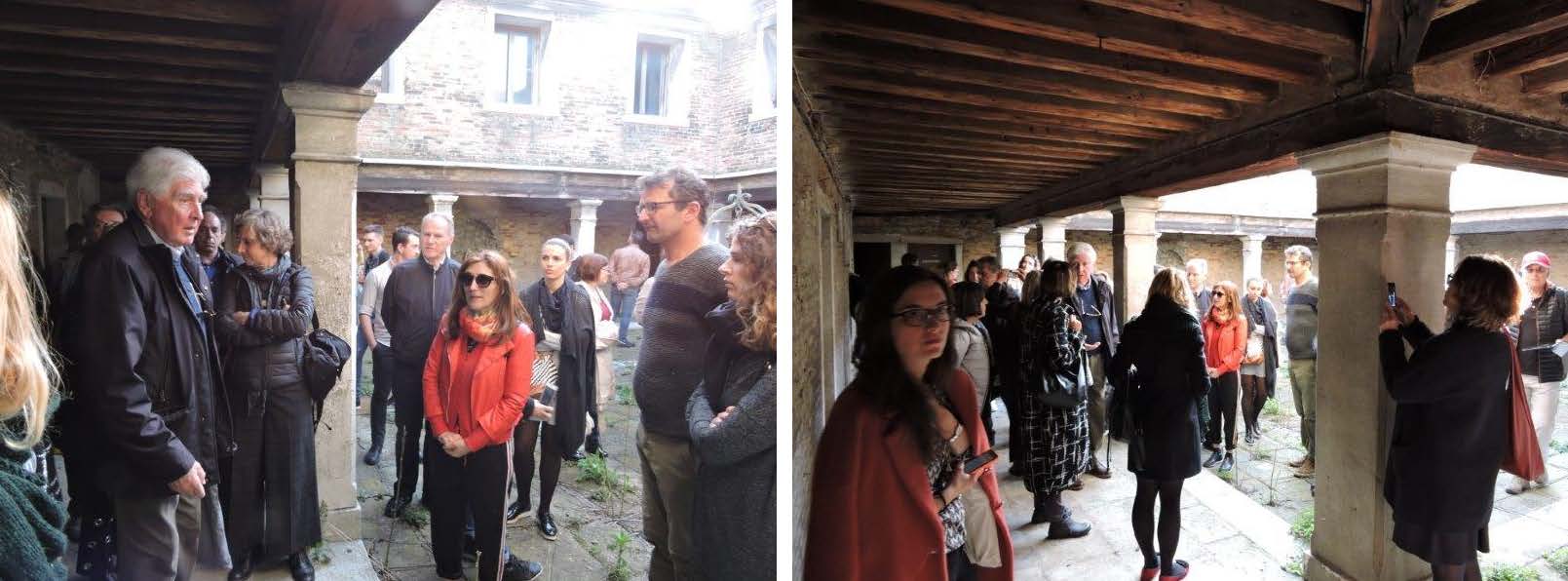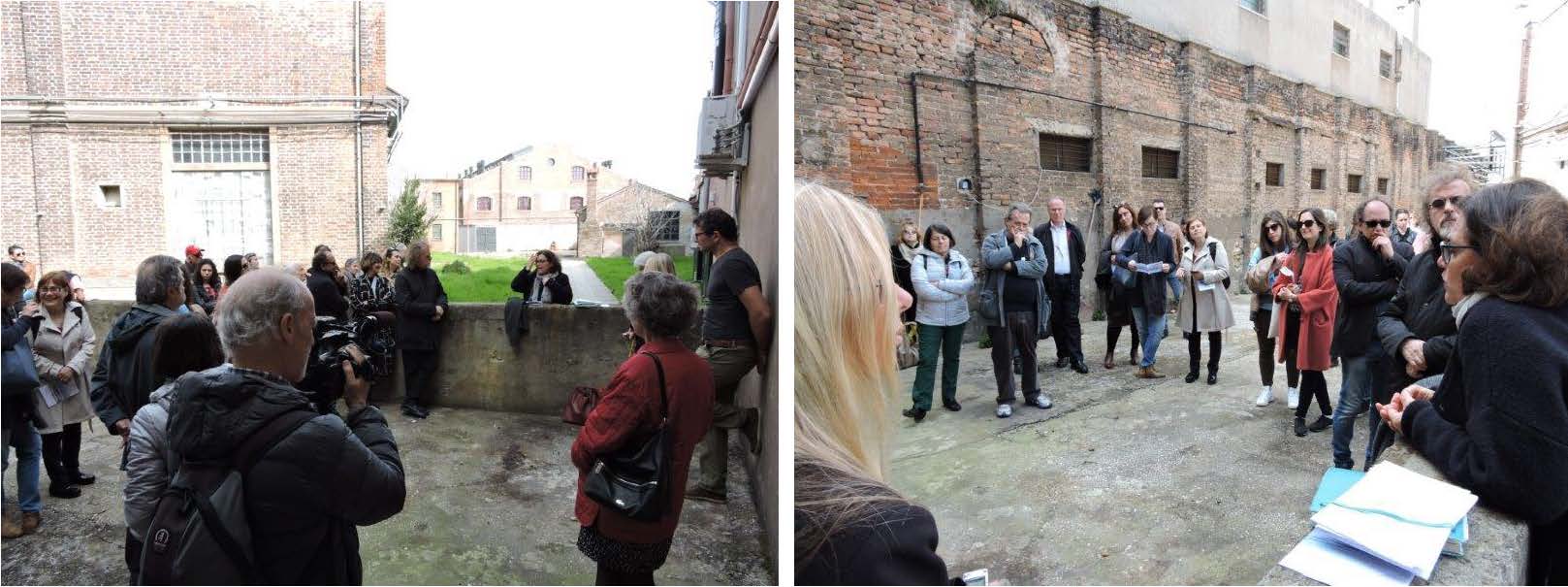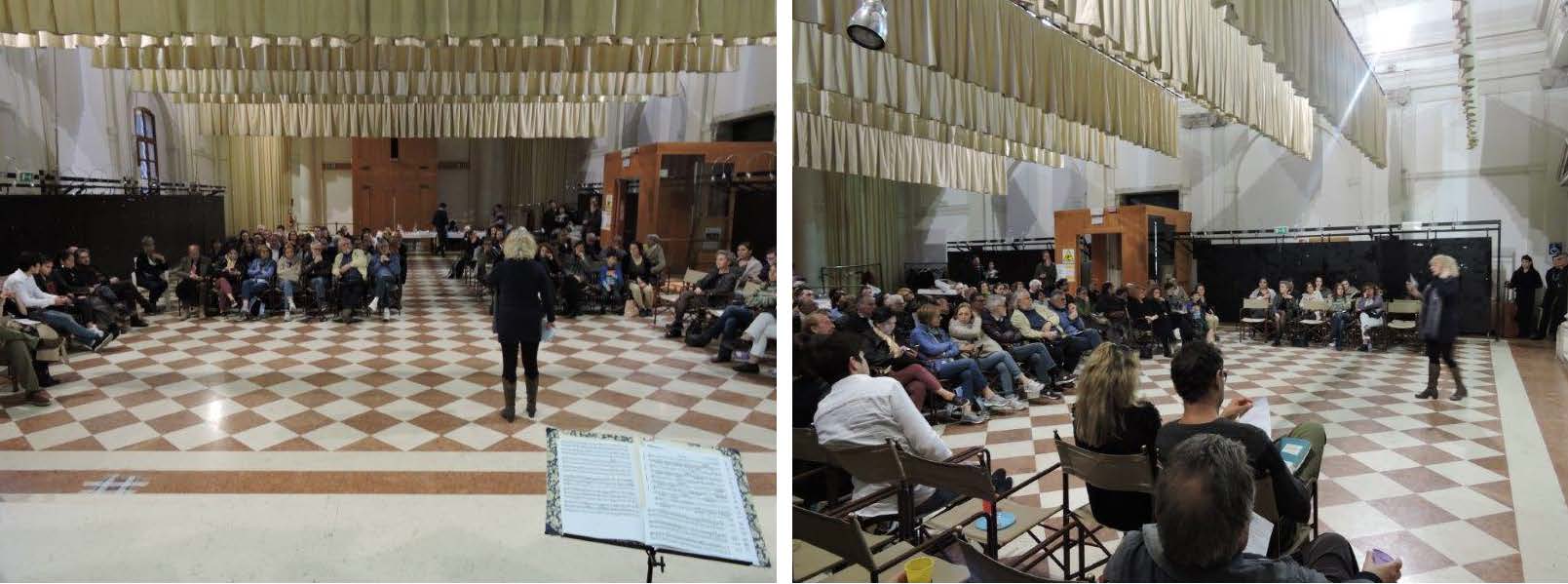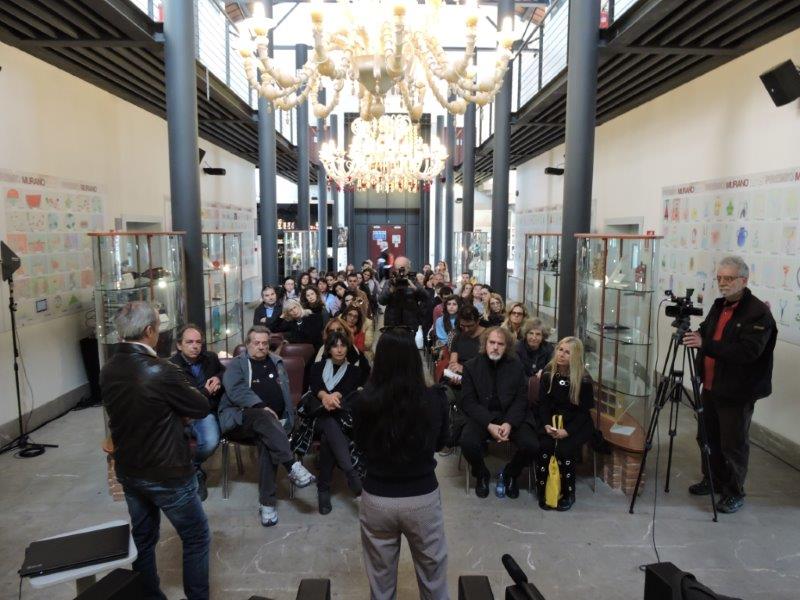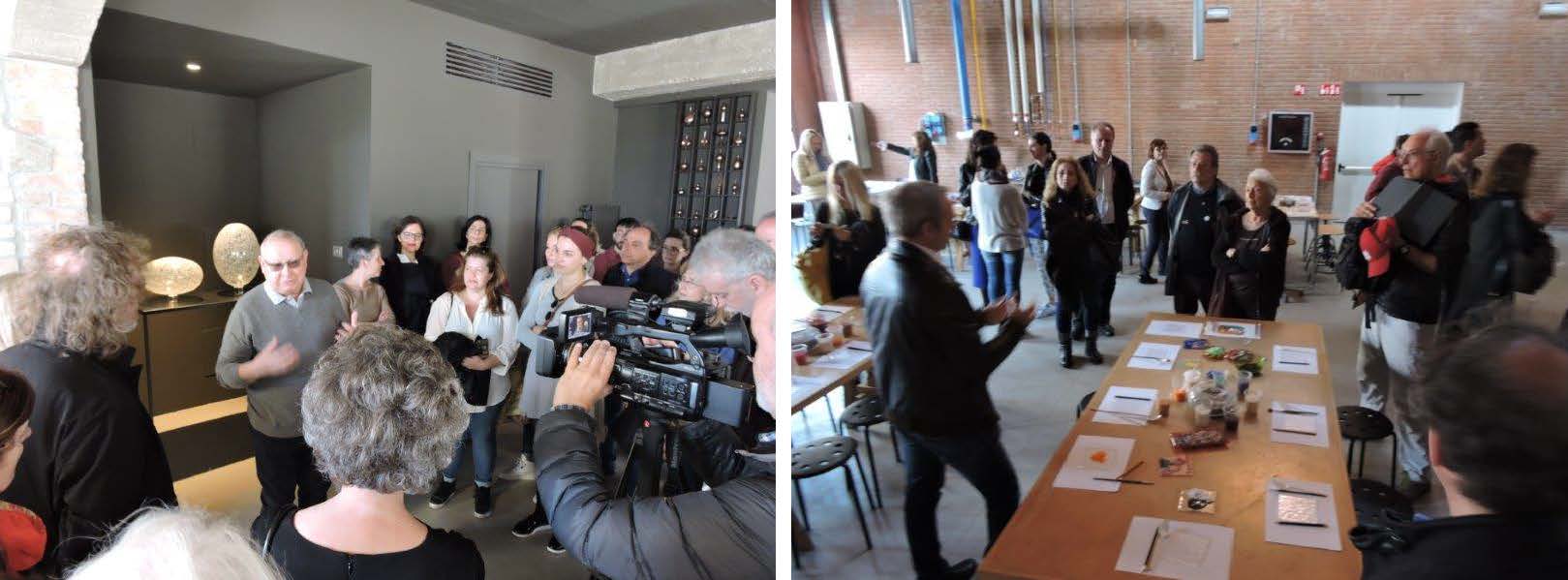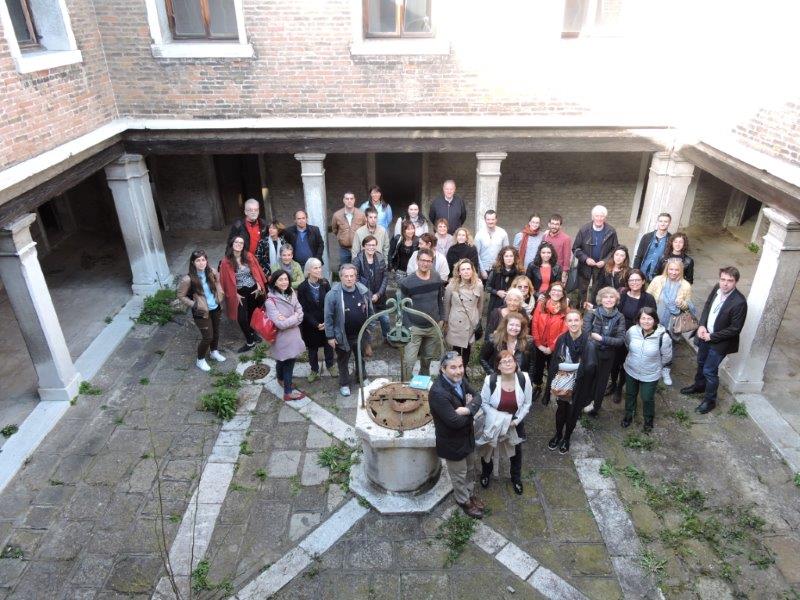Promoted by the Council of Europe in 2005, the Framework Convention on the Value of Cultural Heritage for Society, which is called the Faro Convention by the Portuguese city where Member States met for the opening signature, starts from the idea that the knowledge and use of heritage are part of citizens’ right freely to participate in cultural life, as defined in the Universal Declaration of Human Rights.
In Murano, images of the “Patrimonial Walks” with the participation of the community. (@ F. Calzolaio)
The Convention, introducing the concepts of “cultural heritage” and “heritage communities” “promotes a new vision of the relationship between cultural heritage and the communities that preserve it”. The rights underlined by the Convention are already partially established by the United Nations Universal Declaration of Human Rights (Paris 1948), and by the International Covenant on Economic, Social and Cultural Rights (Paris 1966). The “Portuguese” document integrates the existing tools, adding added values.
The Convention presents cultural heritage both as a resource for human development, the enhancement of cultural diversity and the promotion of intercultural dialogue, and as part of an economic development model based on the principles of sustainable resource use.
In Murano, images of the “Patrimonial Walks” with the participation of the community. (@ F. Calzolaio)
Among the commitments that the signatories take are to “foster an economic and social climate that supports participation in activities inherent in the cultural heritage; promoting the protection of cultural heritage, as a central element of mutually reinforcing objectives: sustainable development, cultural diversity and contemporary creativity; recognize the value of the cultural heritage located in the territories that fall under its jurisdiction, regardless of its origin; formulate integrated strategies to facilitate the implementation of the provisions of this Convention”.
In Muano, images of the “Patrimonial Walks” with the participation of the community. (@ F. Calzolaio)
The Council of Europe Framework Convention on the Value of Cultural Heritage for the Society opens to a new season for cultural policies, promoting a more democratic participation to cultural heritage and a new scheme for the sharing of cultural values. Relevant experimentations on the field have been realized in Marseilles and Venice thanks to a strong participation of local communities organized in ‘heritage communities’ and where the past and modern heritage of the cities has become a ‘common heritage’ belonging to the citizens.
One of the tools adopted for the knowledge and enhancement of the cultural heritage are the Heritage Walks conceived and realized by those who live and work in a specific territory and with whom they have a particular affinity that can be of different nature: historical, cultural, in memory and/or personal experience.
In Murano, images of the “Patrimonial Walks” with the participation of the community. (@ F. Calzolaio)
Patrimonial Walks have as their main objective the promotion of awareness among citizens, perceived as cultural subjects, of their interaction with the cultural heritage in which they live and work and, in particular, of the benefit that comes from living in this “heritage”, both for its historical significance and for its current activities. In particular, they allow to discover or rediscover the value of the territory in which one lives, they can revive personal experiences or make own the experiences of the inhabitants/witnesses, discover new aspects of places. Patrimonial Walks fully interpret the concept of the right to cultural heritage: the patrimonial community uses it to testify its belonging to the territory in which it lives, while visitors, through it, enrich their knowledge and ability to interpret historical dimensions, social and cultural aspects of the territory, cities and neighborhoods.
Patrimonial Walks are normally structured around a significant cultural theme for that area, which serves as a unifying guiding thread for places and people. Preferably set in private places or not usually open to the public, they find their added value in the encounter with the protagonists (witnesses), who bring a living memory of the places, which tell their own direct experience.
In Murano, images of the “Patrimonial Walks” with the participation of the community. (@ F. Calzolaio)
Venice and Marseille were the European pilote cities to adopt this model of application of the convention, then widely spread and recently also “exported” to the Italian earthquake-hit mountain areas of Marche, Umbria, Abruzzo and Lazio with the dual aim of informing and sensitizing institutions and citizenship and, at the same time, boost new participatory management paths.
The Patrimonial Walks therefore become the environment for the formation of active citizenship, encouraging participatory enhancement processes, because they contribute to creating a sense of patrimonial community between participants and organizers, who are at the same time citizens and protagonists of the current use of cultural heritage and its possible future transformations.
In Murano, images of the “Patrimonial Walks” with the participation of the community. (@ F. Calzolaio)
Council of Europe action in the field of cultural heritage targets promoting diversity and dialogue through access to heritage to foster a sense of identity, collective memory and mutual understanding within and between communities.
Head Image: In Murano, images of the “Patrimonial Walks” with the participation of the community. (@ F. Calzolaio)
Passeggiate patrimoniali quale strumento di promozione del valore del patrimonio culturale per la società
La Convenzione, introducendo i concetti di “eredità culturale” e di “comunità di eredità”, “promuove una nuova visione del rapporto tra patrimonio culturale e le comunità che lo custodiscono”. I diritti sottolineati dalla Convenzione sono parzialmente già sanciti, oltre che dalla Dichiarazione universale dei diritti dell’uomo (Parigi 1948), dal Patto internazionale sui diritti economici, sociali e culturali (Parigi 1966). Il documento “portoghese” integra gli strumenti esistenti, apportando valori aggiunti.
La Convenzione presenta il patrimonio culturale come fonte utile allo sviluppo umano sostenibile e per la qualità della vita, alla valorizzazione delle diversità culturali e alla promozione del dialogo interculturale e anche a un modello di sviluppo economico fondato sui principi di utilizzo sostenibile delle risorse.
A Murano, immagini delle “Passeggiate Patrimoniali” con la partecipazione della comunità. (@ F. Calzolaio)
Tra gli impegni che i firmatari prendono vi sono quello di “favorire un clima economico e sociale che sostenga la partecipazione alle attività inerenti l’eredità culturale; promuovere la protezione dell’eredità culturale, quale elemento centrale di obiettivi che si rafforzano reciprocamente: lo sviluppo sostenibile, la diversità culturale e la creatività contemporanea; riconoscere il valore dell’eredità culturale sita nei territori che ricadono sotto la propria giurisdizione, indipendentemente dalla sua origine; formulare strategie integrate per facilitare l’esecuzione delle disposizioni della presente Convenzione”.
A Murano, immagini delle “Passeggiate Patrimoniali” con la partecipazione della comunità. (@ F. Calzolaio)
La Convenzione quadro del Consiglio d’Europa sul valore del patrimonio culturale per la società apre una nuova stagione per le politiche culturali, promuovendo una partecipazione più democratica al patrimonio culturale e un nuovo schema per la condivisione dei valori culturali. Rilevanti esperimenti sul campo sono stati realizzati a Marsiglia e Venezia grazie alla forte partecipazione di comunità locali organizzate in “comunità patrimoniali” e dove il patrimonio passato e presente delle città è diventato un “patrimonio comune” appartenente ai cittadini.
Uno degli strumenti adottati per la conoscenza e la valorizzazione del patrimonio culturale sono le Passeggiate Patrimoniali concepite e realizzate da coloro che vivono e lavorano in un territorio specifico e con cui hanno particolare affinità che può essere di diversa natura: storica, culturale, nella memoria e/o di esperienza personale.
A Murano, immagini delle “Passeggiate Patrimoniali” con la partecipazione della comunità. (@ F. Calzolaio)
Le Passeggiate Patrimonialihanno come obiettivo principale la promozione della consapevolezza tra i cittadini, intesi come soggetti culturali, della loro interazione con il patrimonio culturale in cui vivono e lavorano e, in particolare, del beneficio che deriva dal vivere immersi in questo “patrimonio”, tanto per la sua portata storica, quanto per le attività attuali. In particolare, esse permettono di scoprire o riscoprire il valore del territorio in cui si vive, possono far rivivere esperienze personali o fare proprie esperienze degli abitanti/testimoni, scoprire nuovi aspetti di luoghi che si credeva conosciuti nella loro totalità. Le Passeggiate patrimoniali interpretano in senso pieno il concetto di diritto al patrimonio culturale: la comunità patrimoniale la usa per testimoniare la propria appartenenza al territorio in cui abita mentre i visitatori, attraverso di essa, arricchiscono la propria conoscenza e capacità di interpretazione delle dimensioni storiche, sociali e culturali del territorio, delle città e dei quartieri.
A Murano, immagini delle “Passeggiate Patrimoniali” con la partecipazione della comunità. (@ F. Calzolaio)
Le Passeggiate Patrimoniali si articolano normalmente intorno ad un tema culturale significativo per quel territorio, che funga da filo conduttore unificante per luoghi e persone. Preferibilmente ambientate in luoghi privati o comunque non abitualmente aperti al pubblico, trovano il loro valore aggiunto nell’incontro con i protagonisti (testimoni), che portano una memoria viva dei luoghi e che raccontano la propria esperienza diretta.
A Murano, immagini delle “Passeggiate Patrimoniali” con la partecipazione della comunità. (@ F. Calzolaio)
Venezia e Marsiglia sono state le città europee pilota ad adottare questo modello di applicazione della convenzione, poi diffuso ampiamente e di recente anche “esportato” nelle aree montane terremotate di Marche, Umbria, Abruzzo e Lazio con il duplice intento di informare e sensibilizzare istituzioni e cittadinanza e, al tempo stesso, dare impulso a nuovi percorsi di gestione partecipata.
Le Passeggiate Patrimoniali diventano quindi l’ambiente di formazione della cittadinanza attiva, incoraggiando processi di valorizzazione partecipativi, perché contribuiscono a creare un senso di comunità patrimoniale tra partecipanti e organizzatori, che sono al tempo stesso cittadini e protagonisti dell’uso attuale del patrimonio culturale e delle sue possibili trasformazioni future.
Head Image: A Murano, immagini delle “Passeggiate Patrimoniali” con la partecipazione della comunità. (@ F. Calzolaio).
